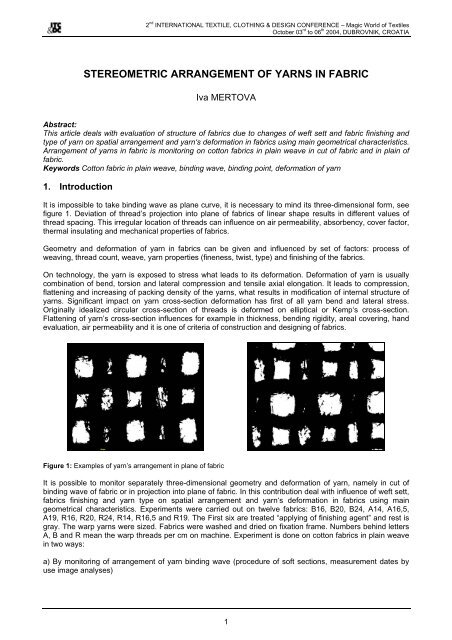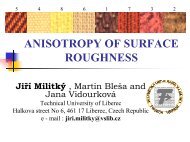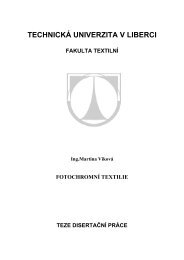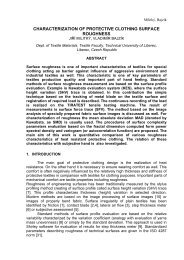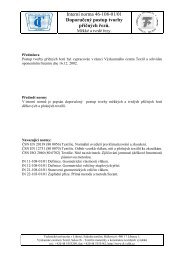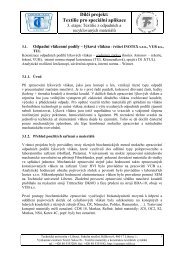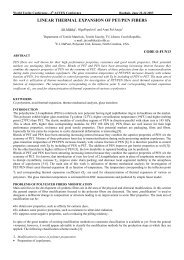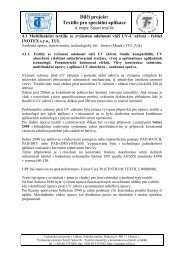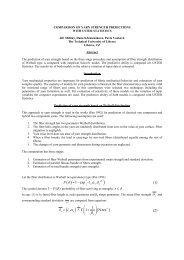TITLE OF PAPER - Centrum Textil
TITLE OF PAPER - Centrum Textil
TITLE OF PAPER - Centrum Textil
Create successful ePaper yourself
Turn your PDF publications into a flip-book with our unique Google optimized e-Paper software.
2 nd INTERNATIONAL TEXTILE, CLOTHING & DESIGN CONFERENCE – Magic World of <strong>Textil</strong>es<br />
October 03 rd to 06 th 2004, DUBROVNIK, CROATIA<br />
STEREOMETRIC ARRANGEMENT <strong>OF</strong> YARNS IN FABRIC<br />
Iva MERTOVA<br />
Abstract:<br />
This article deals with evaluation of structure of fabrics due to changes of weft sett and fabric finishing and<br />
type of yarn on spatial arrangement and yarn‘s deformation in fabrics using main geometrical characteristics.<br />
Arrangement of yarns in fabric is monitoring on cotton fabrics in plain weave in cut of fabric and in plain of<br />
fabric.<br />
Keywords Cotton fabric in plain weave, binding wave, binding point, deformation of yarn<br />
1. Introduction<br />
It is impossible to take binding wave as plane curve, it is necessary to mind its three-dimensional form, see<br />
figure 1. Deviation of thread’s projection into plane of fabrics of linear shape results in different values of<br />
thread spacing. This irregular location of threads can influence on air permeability, absorbency, cover factor,<br />
thermal insulating and mechanical properties of fabrics.<br />
Geometry and deformation of yarn in fabrics can be given and influenced by set of factors: process of<br />
weaving, thread count, weave, yarn properties (fineness, twist, type) and finishing of the fabrics.<br />
On technology, the yarn is exposed to stress what leads to its deformation. Deformation of yarn is usually<br />
combination of bend, torsion and lateral compression and tensile axial elongation. It leads to compression,<br />
flattening and increasing of packing density of the yarns, what results in modification of internal structure of<br />
yarns. Significant impact on yarn cross-section deformation has first of all yarn bend and lateral stress.<br />
Originally idealized circular cross-section of threads is deformed on elliptical or Kemp‘s cross-section.<br />
Flattening of yarn’s cross-section influences for example in thickness, bending rigidity, areal covering, hand<br />
evaluation, air permeability and it is one of criteria of construction and designing of fabrics.<br />
Figure 1: Examples of yarn’s arrangement in plane of fabric<br />
It is possible to monitor separately three-dimensional geometry and deformation of yarn, namely in cut of<br />
binding wave of fabric or in projection into plane of fabric. In this contribution deal with influence of weft sett,<br />
fabrics finishing and yarn type on spatial arrangement and yarn‘s deformation in fabrics using main<br />
geometrical characteristics. Experiments were carried out on twelve fabrics: B16, B20, B24, A14, A16,5,<br />
A19, R16, R20, R24, R14, R16,5 and R19. The First six are treated “applying of finishing agent” and rest is<br />
gray. The warp yarns were sized. Fabrics were washed and dried on fixation frame. Numbers behind letters<br />
A, B and R mean the warp threads per cm on machine. Experiment is done on cotton fabrics in plain weave<br />
in two ways:<br />
a) By monitoring of arrangement of yarn binding wave (procedure of soft sections, measurement dates by<br />
use image analyses)<br />
1
2 nd INTERNATIONAL TEXTILE, CLOTHING & DESIGN CONFERENCE – Magic World of <strong>Textil</strong>es<br />
October 03 rd to 06 th 2004, DUBROVNIK, CROATIA<br />
b) By monitoring yarn geometry in plain of fabrics (scanning of pictures of fabrics, modification of pictures<br />
and measurement dates by use of image analyses).<br />
Both of procedures are compared.<br />
2. Yarn’s geometry in binding wave<br />
Yarn’s geometry in binding wave is monitoring by sett of geometrical parameters. These parameters<br />
describe yarn waviness in fabric’s cut and yarn's deformation in binding point.<br />
2.1 Yarn’s deformation in binding point<br />
In contact point of two yarns, consequently in binding point, there is compression and enlargement of yarn.<br />
Inner structure of yarn changes is depending on this deformation. The yarn cross section is deformed by the<br />
bending and compression. Original circular cross-sectional shape changes to Kemp’s cross-section. This<br />
shape may be changed to elliptical cross section, with general axes A, B. Where A is enlargement, B is<br />
compression, see figure 2.<br />
Figure 2 Deformed cross section of yarn in binding point<br />
Geometrical parameters were measured from the images of textile cross sections. Warp thread spacing p 1<br />
[µm], weft thread spacing p 2 [µm], warp enlargement A 1 [µm], weft enlargement A 2 [µm], warp compression<br />
B 1 [µm], weft compression B 2 [µm] and amplitudes of warp and weft binding waves h 1 and h 2. , were<br />
measured by means of image analysis on figure 3. From the measured data of enlargement and<br />
compression are calculated values of flattening of yarn in binding point<br />
γ = A/B (1)<br />
Figure 3: Cut of warp binding wave<br />
The influence of weft sett, of finishing of fabric and type of yarn on yarn’s geometry in binding point is<br />
discussed with reference to flattening parameter. It is plotted in figure 4.<br />
Parameters<br />
2<br />
1,9<br />
1,8<br />
1,7<br />
1,6<br />
1,5<br />
Flattening of yarn<br />
A1/B1[1]<br />
A2/B2[1]<br />
B 16 B 20 B 24 R 16 R 20 R 24<br />
Fabric<br />
Parameters<br />
2,6<br />
2,4<br />
2,2<br />
2<br />
1,8<br />
1,6<br />
Flattening of yarn<br />
A1/B1[1]<br />
a. b.<br />
A2/B2[1]<br />
A 14 A 16,5 A 19 R 14 R 16,5 R 19<br />
Fabric<br />
Figure 4: Dependence of yarn’s flattening in fabric’s binding point on weft thread count and finish of fabrics: a) fabrics<br />
from single yarn, b) fabrics from ply yarn<br />
2
2 nd INTERNATIONAL TEXTILE, CLOTHING & DESIGN CONFERENCE – Magic World of <strong>Textil</strong>es<br />
October 03 rd to 06 th 2004, DUBROVNIK, CROATIA<br />
From values of flattening in binding point, it was found: Increasing weft sett hasn’t influence on values of<br />
yarn’s flattening in binding point on fabric from single yarn. But increasing weft sett on fabric from ply yarn<br />
influences yarns flattening. Finishing of fabric influences flattening. Weft yarns are more deformed in the<br />
finished fabric. Warp yarns are more deformed in the gray fabric by contrast.<br />
2.2 Waviness of yarn in cut of fabric<br />
Waviness of yarn in cut of fabric is described with warp and weft thread spacing, see figure 5; and with warp<br />
and weft amplitude of binding wave, see figure 6. Difference between values of warp thread spacing isn’t<br />
statistically insignificant in gray and finished fabrics too. Values of warp thread spacing are different in<br />
dependence on weft thread count. From experiment it was found, that the weft threads spacing decreases<br />
with increasing of weft thread count for all fabrics. Increasing weft sett hasn’t influence on weft thread<br />
spacing.<br />
In consequence with finishing, warp thread spacing of finished fabric is lower than warp thread spacing of<br />
gray fabric; even the original sett on the machine is the same. The difference is statistically insignificant.<br />
Finishing doesn’t influence values of thread spacing.<br />
Warp and weft thread spacing<br />
Warp and weft thread spacing<br />
p1[µm]<br />
p2[µm]<br />
p1[µm]<br />
p2[µm]<br />
Thread spacing<br />
700<br />
650<br />
600<br />
550<br />
500<br />
450<br />
400<br />
B 16 B 20 B 24 R 16 R 20<br />
Fabric<br />
Thread spacing<br />
800<br />
700<br />
600<br />
500<br />
400<br />
A 14 A 16,5 A 19 R14 R16,5 R19<br />
Fabric<br />
a. b.<br />
Figure 5: Dependence of thread spacing on weft thread count and finishing of fabrics: a) fabrics from single yarn; b)<br />
fabrics from ply yarn<br />
Mean value of warp amplitude of binding wave decrease with increasing weft thread count. Mean value of<br />
weft amplitude of binding wave increase with increasing weft thread count for all fabric; without reference to<br />
finishing of fabric and type of yarn. Weft thread spacing decreases and length of binding wave increases with<br />
increasing weft thread count. It means, that longer yarn’s segment is bent more than shorter. So, increasing<br />
weft thread count influences geometry of all fabrics. For fabric from single yarn, ply yarn, for gray or finished<br />
too.<br />
Warp and weft high of binding wave<br />
Warp and weft high of binding wave<br />
h1[µm]<br />
h2[µm]<br />
h1[µm]<br />
h2[µm]<br />
High of binding wave<br />
210<br />
190<br />
170<br />
150<br />
130<br />
B 16 B 20 B 24 R 16 R 20 R 24<br />
Fabric<br />
High of binding wave<br />
340<br />
290<br />
240<br />
190<br />
140<br />
A 14 A 16,5 A 19 R 14 R 16,5 R 19<br />
Fabric<br />
a. b.<br />
Figure 6: Dependence of amplitude of binding wave on weft thread count and finish of fabrics: a) fabrics from single<br />
yarn; b) fabrics from ply yarn<br />
Influence of finishing on amplitude of binding wave is showed through flattening of yarns in binding point and<br />
through thread spacing. Values of yarn’s flattening are generally higher for gray fabric and thread spacing<br />
3
2 nd INTERNATIONAL TEXTILE, CLOTHING & DESIGN CONFERENCE – Magic World of <strong>Textil</strong>es<br />
October 03 rd to 06 th 2004, DUBROVNIK, CROATIA<br />
values are generally less for gray fabric. Consequently are high of warp thread of gray fabric higher than for<br />
finished fabric.<br />
2.3 Result<br />
Generally it was found: It is impossible to tell, that deformation of yarn in binding point depends on change of<br />
weft thread count for all fabrics. Deformation of yarn in binding point depends on weft thread count only for<br />
fabric from twisted yarn.<br />
Shape of binding wave (waviness) is described with warp and weft thread spacing and warp and weft<br />
amplitude of binding wave for all fabric. Values of these parameters depend on change of weft thread count.<br />
Fabric’s finishing influences all fabric parameters within thread spacing. It can be say that arrangement of<br />
yarn in fabric depends on fabric’s finishing.<br />
3. Yarn’s geometry in plane of fabric<br />
Laboratory classification procedure was developed to measure of yarn’s geometry in plane of fabric image<br />
analysis Lucia G to use (optimal size of sample and zoom, scanning of fabric’s picture, modification and<br />
transformation of fabric’s picture to the same scanning dates from picture).<br />
Every unloaded picture was processed in the same way to be like each other to detect boundary-line<br />
between body yarn and gaps between separate yarns. Scanned coloured images were transformed<br />
independently in RGB components. These RGB components (red, green and blue) are the same for all<br />
images. Colour picture was then transformed on so-called overlay picture.<br />
Another modification was morphological erosion and dilation of image. Erosion removes a layer of pixels all<br />
around an object. An object with thinner sections compared to matrix structuring element breaks into two<br />
parts. Dilation expands objects and structures in a binary image. Neighbouring objects are connected and<br />
small holes are filled. Overlay image was transformed to binary image. Examples of binary images are<br />
showed in figure 7.<br />
a. b.<br />
Figure 7: Binary image of a) fabrics from ply yarn; b) fabrics from single yarn<br />
From binary images were measured data on function interactive length measurement. The influence of weft<br />
sett and finishing and yarn’s type on fabric’s geometry is discussed with reference to gaps (distance between<br />
two neighbours yarns) and to yarn’s diameter D 1 a D 2 between two binding points. These parameters are<br />
changed unambiguously with weft thread count. Comparison of diameters D 1 , D 2 a D is showed in the figure<br />
8. D is diameter of free yarn.<br />
4
2 nd INTERNATIONAL TEXTILE, CLOTHING & DESIGN CONFERENCE – Magic World of <strong>Textil</strong>es<br />
October 03 rd to 06 th 2004, DUBROVNIK, CROATIA<br />
Comparison of yarn's diameters<br />
0,28<br />
D1 D2 D Comparison of yarn's diameters<br />
0,5<br />
D1 D2 D<br />
Diameter [mm]<br />
0,26<br />
0,24<br />
0,22<br />
Diameter [mm]<br />
0,45<br />
0,4<br />
0,35<br />
0,2<br />
B16 B20 B24 R16 R20 R24<br />
Fabric<br />
0,3<br />
A14 A165 A19 R14 R165 R19<br />
Fabric<br />
a. b.<br />
Figure 8: Comparison of yarn’s diameters for a) fabrics from single yarn; b) fabrics from ply yarn<br />
Difference between parameters values is statistically significant for gray and finished fabrics. Finishing of<br />
fabric influences shape of binding wave in plane of fabric. In accordance with yarn’s diameter measured<br />
between binding points it is possible to find: Weft yarns are more deformed in the finished fabric. Warp yarns<br />
are more deformed in the gray fabric by contrast.<br />
3.1 Comparison of woven-in yarn diameters D 1 , D 2 with enlargement in binding point of fabric A 1 , A 2<br />
Diameters of woven-in yarns are measured in plane of fabric and enlargements of yarn in binding point are<br />
measured in cut of binding wave of fabric. According to assumption are more deformed yarns in binding<br />
point. Loading leads to compression of yarns and it is transferred to yarn’s section between two binding<br />
points. The difference of yarn’s deformations in binding point and between two binding points is smaller for<br />
finished fabrics than gray fabrics. Single yarn is more deformed than ply yarn.<br />
Comparison of diameter and enlargement<br />
A1 D1 A2 D2<br />
0,5<br />
Parameters [mm]<br />
0,45<br />
0,4<br />
0,35<br />
0,3<br />
0,25<br />
0,2<br />
A14<br />
A16,5<br />
A19<br />
R14<br />
R16,5<br />
R19<br />
B16<br />
Fabric<br />
B20<br />
B24<br />
R16<br />
R20<br />
R24<br />
Figure 9: Comparison of warp and weft diameters and warp and weft enlargement for all fabrics.<br />
3.2 Result<br />
Generally it is possible to tell for all fabrics: Values of weft and warp parameters decrease with increasing<br />
weft thread count and the difference between values is statistically significant for all fabric. Mean values of<br />
parameters are higher for gray fabrics than for finished fabrics. So, waviness in plane of fabric depended on<br />
weft thread count. All parameters values of all fabrics are depended on fabric’s finishing. It can be say that<br />
finishing influences arrangement of yarn in plane of fabric.<br />
5
2 nd INTERNATIONAL TEXTILE, CLOTHING & DESIGN CONFERENCE – Magic World of <strong>Textil</strong>es<br />
October 03 rd to 06 th 2004, DUBROVNIK, CROATIA<br />
4. Conclusion<br />
Single yarn’s deformation in binding point isn’t depended on weft sett. In contrast, ply yarn’s deformation is<br />
depended on weft thread count. Shape of binding wave is described with thread spacing and amplitude of<br />
binding wave. Weft thread count influences values of these parameters. Arrangement of yarn in cut of fabric<br />
is depend on fabric’s finishing. Finishing doesn’t influence values of thread spacing. Arrangement of yarn<br />
and deformation in plane of fabric is depend on weft thread count and on fabric’s finishing.<br />
Comparison of both methodic was made with respect to thread spacing. The difference between values from<br />
both methodic doesn’t exceed 15% for all fabrics. For any fabric are these values the same.<br />
Acknowledgements:<br />
This work was supported by the research project LN 00 B090 of Czech Ministry of Education.<br />
References<br />
[1] Nosek, S.: Structure and geometry of fabrics (in Czech), VÚB, Usti nad Orlici, (1974)<br />
[2] Kovar, R.: Structure and properties of flat fabrics (in Czech), TU of Liberec, 80-7083-676-8,<br />
Liberec, (2003)<br />
[3] Drasarova, J.: Thread deformation in fabric’s binding point (in Czech). Liberec, (2003)<br />
[4] Composite authors: Internal standards. Research centre <strong>Textil</strong>e, Liberec, (2002)<br />
Iva MERTOVA, M.Sc.<br />
Technical university of Liberec<br />
Hálkova 6, 461 17 Liberec, Czech Republic<br />
Phone: +(420) (48) 535 3628 Fax: +(420) (48) 535 3542 E-mail: iva_mertova@vslib.cz<br />
6


